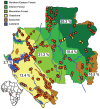High prevalence of both humoral and cellular immunity to Zaire ebolavirus among rural populations in Gabon
- PMID: 20161740
- PMCID: PMC2817732
- DOI: 10.1371/journal.pone.0009126
High prevalence of both humoral and cellular immunity to Zaire ebolavirus among rural populations in Gabon
Erratum in
- PLoS One. 2010;5(2) doi: 10.1371/annotation/9bc62f9e-8386-4e9b-951c-1eeba930a41c
Abstract
To better understand Zaire ebolavirus (ZEBOV) circulation and transmission to humans, we conducted a large serological survey of rural populations in Gabon, a country characterized by both epidemic and non epidemic regions. The survey lasted three years and covered 4,349 individuals from 220 randomly selected villages, representing 10.7% of all villages in Gabon. Using a sensitive and specific ELISA method, we found a ZEBOV-specific IgG seroprevalence of 15.3% overall, the highest ever reported. The seroprevalence rate was significantly higher in forested areas (19.4%) than in other ecosystems, namely grassland (12.4%), savannah (10.5%), and lakeland (2.7%). No other risk factors for seropositivity were found. The specificity of anti-ZEBOV IgG was confirmed by Western blot in 138 individuals, and CD8 T cells from seven IgG+ individuals were shown to produce IFN-gamma after ZEBOV stimulation. Together, these findings show that a large fraction of the human population living in forested areas of Gabon has both humoral and cellular immunity to ZEBOV. In the absence of identified risk factors, the high prevalence of "immune" persons suggests a common source of human exposure such as fruits contaminated by bat saliva. These findings provide significant new insights into ZEBOV circulation and human exposure, and raise important questions as to the human pathogenicity of ZEBOV and the existence of natural protective immunization.
Conflict of interest statement
Figures






Similar articles
-
Risk factors for Zaire ebolavirus--specific IgG in rural Gabonese populations.J Infect Dis. 2011 Nov;204 Suppl 3:S768-75. doi: 10.1093/infdis/jir344. J Infect Dis. 2011. PMID: 21987749
-
Low seroprevalence of IgG antibodies to Ebola virus in an epidemic zone: Ogooué-Ivindo region, Northeastern Gabon, 1997.J Infect Dis. 2005 Mar 15;191(6):964-8. doi: 10.1086/427994. Epub 2005 Feb 8. J Infect Dis. 2005. PMID: 15717273
-
Large serological survey showing cocirculation of Ebola and Marburg viruses in Gabonese bat populations, and a high seroprevalence of both viruses in Rousettus aegyptiacus.BMC Infect Dis. 2009 Sep 28;9:159. doi: 10.1186/1471-2334-9-159. BMC Infect Dis. 2009. PMID: 19785757 Free PMC article.
-
Longitudinal antibody and T cell responses in Ebola virus disease survivors and contacts: an observational cohort study.Lancet Infect Dis. 2021 Apr;21(4):507-516. doi: 10.1016/S1473-3099(20)30736-2. Epub 2020 Oct 13. Lancet Infect Dis. 2021. PMID: 33065039 Free PMC article.
-
Correlates of vaccine-induced protective immunity against Ebola virus disease.Semin Immunol. 2018 Oct;39:65-72. doi: 10.1016/j.smim.2018.07.003. Epub 2018 Jul 21. Semin Immunol. 2018. PMID: 30041831 Review.
Cited by
-
Multiple circulating infections can mimic the early stages of viral hemorrhagic fevers and possible human exposure to filoviruses in Sierra Leone prior to the 2014 outbreak.Viral Immunol. 2015 Feb;28(1):19-31. doi: 10.1089/vim.2014.0108. Viral Immunol. 2015. PMID: 25531344 Free PMC article.
-
Evaluating the frequency of asymptomatic Ebola virus infection.Philos Trans R Soc Lond B Biol Sci. 2017 May 26;372(1721):20160303. doi: 10.1098/rstb.2016.0303. Philos Trans R Soc Lond B Biol Sci. 2017. PMID: 28396474 Free PMC article.
-
Pre-Pandemic Cross-Reactive Immunity against SARS-CoV-2 among Central and West African Populations.Viruses. 2022 Oct 14;14(10):2259. doi: 10.3390/v14102259. Viruses. 2022. PMID: 36298814 Free PMC article.
-
Serological Evidence of Ebola Virus Infection in Rural Guinea before the 2014 West African Epidemic Outbreak.Am J Trop Med Hyg. 2018 Aug;99(2):425-427. doi: 10.4269/ajtmh.18-0105. Epub 2018 May 31. Am J Trop Med Hyg. 2018. PMID: 29869602 Free PMC article.
-
Early transmission and case fatality of Ebola virus at the index site of the 2013-16 west African Ebola outbreak: a cross-sectional seroprevalence survey.Lancet Infect Dis. 2019 Apr;19(4):429-438. doi: 10.1016/S1473-3099(18)30791-6. Epub 2019 Feb 21. Lancet Infect Dis. 2019. PMID: 30799252 Free PMC article.
References
-
- Sanchez A, Geisbert TW, Feldmann H. Filoviridae: Marburg and Ebola viruses. In: Knipe DM, Howley PM, editors. Fields virology. Philadelphia: Lippincott Williams and Williams; 2007. pp. 1409–1448.
-
- Feldmann H, Geisbert TW, Jahrling PB, Klenk HD, Netesov SV, et al. Filoviridae. In: Fauquet CM, Mayo MA, Maniloff J, Desselberger U, Ball LA, editors. Virus taxonomy: VIIIth report of the international committee on taxonomy of viruses. London, United Kingdom: Elsevier Academic Press; 2005. pp. 645–653.
-
- Jahrling PB, Geisbert TW, Dalgard DW, Johnson ED, Ksiazek TG, et al. Preliminary report: isolation of Ebola virus from monkeys imported to USA. Lancet. 1990;335:502–505. - PubMed
-
- Rollin PE, Williams RJ, Bressler DS, Pearson S, Cottingham M, et al. Ebola (subtype Reston) virus among quarantined nonhuman primates recently imported from the Philippines to the United States. J Infect Dis. 1999;179:S108–S114. - PubMed
-
- Barrette RW, Metwally SA, Rowland JM, Xu L, Zaki SR, et al. Discovery of swine as a host for the Reston ebolavirus. Science. 2009;325:204–206. - PubMed
Publication types
MeSH terms
Substances
LinkOut - more resources
Full Text Sources
Medical
Research Materials

